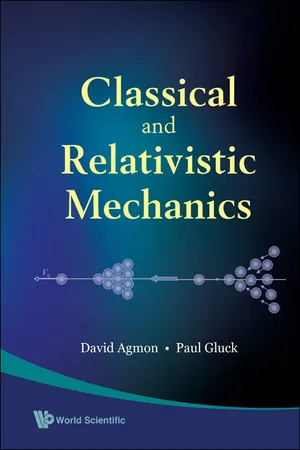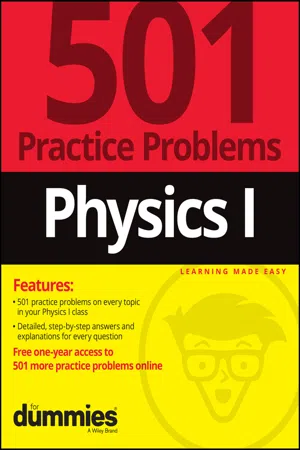Physics
Angular Acceleration and Centripetal Acceleration
Angular acceleration refers to the rate of change of angular velocity of an object as it moves in a circular path. It is measured in radians per second squared. Centripetal acceleration, on the other hand, is the acceleration directed towards the center of the circular path and is responsible for keeping an object moving in a curved path.
Written by Perlego with AI-assistance
Related key terms
1 of 5
10 Key excerpts on "Angular Acceleration and Centripetal Acceleration"
- eBook - PDF
- Paul Peter Urone, Roger Hinrichs(Authors)
- 2012(Publication Date)
- Openstax(Publisher)
The direction of the angular velocity is clockwise in this case. PhET Explorations: Ladybug Revolution Figure 6.7 Ladybug Revolution (http://cnx.org/content/m42083/1.7/rotation_en.jar) Join the ladybug in an exploration of rotational motion. Rotate the merry-go-round to change its angle, or choose a constant angular velocity or angular acceleration. Explore how circular motion relates to the bug's x,y position, velocity, and acceleration using vectors or graphs. 6.2 Centripetal Acceleration We know from kinematics that acceleration is a change in velocity, either in its magnitude or in its direction, or both. In uniform circular motion, the direction of the velocity changes constantly, so there is always an associated acceleration, even though the magnitude of the velocity might be constant. You experience this acceleration yourself when you turn a corner in your car. (If you hold the wheel steady during a turn and move at constant speed, you are in uniform circular motion.) What you notice is a sideways acceleration because you and the car are changing direction. The sharper the curve and the greater your speed, the more noticeable this acceleration will become. In this section we examine the direction and magnitude of that acceleration. Figure 6.8 shows an object moving in a circular path at constant speed. The direction of the instantaneous velocity is shown at two points along the path. Acceleration is in the direction of the change in velocity, which points directly toward the center of rotation (the center of the circular path). This pointing is shown with the vector diagram in the figure. We call the acceleration of an object moving in uniform circular motion (resulting from a net external force) the centripetal acceleration( a c ); centripetal means “toward the center” or “center seeking.” 204 Chapter 6 | Uniform Circular Motion and Gravitation This OpenStax book is available for free at http://cnx.org/content/col11406/1.9 - eBook - PDF
- Richard L. Myers(Author)
- 2005(Publication Date)
- Greenwood(Publisher)
Angular velocity is related to tan- gential velocity according to the equation v = rco. The change in magnitude of the angular velocity divided by the change in time is the average angular acceleration, a: Aw a = A^ The units for angular acceleration are typically radians per second 2 , or rad-s~ 2 . The instantaneous angular acceleration is calculated by using a small time inter- val. Using the uniformly accelerating car example, the average and instantaneous acceleration of the car are equal (due to the fact that acceleration is constant). If the car took 20 s to accelerate to 200 rpm (equivalent to approximately 21 rad/ s), then the angular acceleration would be 58 Rotational Motion This means that each second the engine's crankshaft is turning 1.05 rad/s faster. The relationship between tangential acceleration and angular acceleration is a t = ra. Rotational Dynamics In translational motion, an equilibrium condition exists when an object is not accel- erating and there is no net force acting on an object. Rotational equilibrium exists when an object is not rotating. In order for an object to be in rotational equilibrium, forces acting on an object that cause rotation must sum to zero. A force that acts to produce rota- tion is known as a torque. A torque depends on both the force and where the force acts. For example, consider a book resting on a smooth table. If you use your finger to push the book in the middle along its axis of sym- metry, the book will slide across the table. (Figure 4.7). Now consider what happens when you push the book at one of its edges. Rather than sliding along the table, the book rotates around an axis perpendicular to the center of the book. The difference in the two situations in Figure 4.7 arises due to the fact that an unbalanced torque exists when push- ing the book along the edge. In both cases the force acting is the same, but the posi- tion where the force is applied can create an unbalanced torque. - eBook - PDF
- John D. Cutnell, Kenneth W. Johnson, David Young, Shane Stadler(Authors)
- 2021(Publication Date)
- Wiley(Publisher)
8.5 Centripetal Acceleration and Tangential Acceleration 229 acceleration, as emphasized in Chapter 5. That chapter deals with uniform circular motion, in which a particle moves at a constant tangential speed on a circular path. The tangential speed υ T is the magnitude of the tangential velocity vector. Even when the magnitude of the tangential velocity is constant, an acceleration is present, since the direction of the velocity changes continually. Because the resulting acceleration points toward the center of the circle, it is called the centripetal acceleration. Interactive Figure 8.12a shows the centripetal acceleration → a c for a model airplane flying in uni- form circular motion on a guide wire. The magnitude of → a c is a c = υ T 2 ___ r (5.2) The subscript “t” has now been included in this equation as a reminder that it is the tangential speed that appears in the numerator. The centripetal acceleration can be expressed in terms of the angular speed ω by using υ T = rω (Equation 8.9): a c = υ T 2 ___ r = (rω) 2 _____ r = r ω 2 (ω in rad/s ) (8.11) Only radian measure (rad/s) can be used for ω in this result, since the relation υ T = rω presumes radian measure. While considering uniform circular motion in Chapter 5, we ignored the details of how the motion is established in the first place. In Interactive Figure 8.12b, for instance, the engine of the plane produces a thrust in the tangential direction, and this force leads to a tangential acceleration. In response, the tangential speed of the plane increases from moment to moment, until the situation shown in the drawing results. While the tangential speed is changing, the motion is called nonuniform circular motion. Interactive Figure 8.12b illustrates an important feature of nonuniform circu- lar motion. Since the direction and the magnitude of the tangential velocity are both changing, the airplane experiences two acceleration components simultaneously. - eBook - PDF
- Michael Tammaro(Author)
- 2019(Publication Date)
- Wiley(Publisher)
130 Motion Along a Circular Path 5 In the sport of Grand Prix motorcycle racing, motorcycles compete on closed-loop, paved tracks. Although the length and shape of the track varies from venue to venue, all of them have a number of turns. The sharpness of a turn is quantified by its radius of curvature (defined as the radius of the circle that would be formed by continuing the turn until it closed onto itself). These turns, taken at high speeds, are a dramatic illustration of motion along a circular path. Although the speed of the motorcycles is approximately constant through a turn, there is plenty of acceleration due to the turning. Acceleration due to the changes in direction is called centripetal acceleration. David Acosta Allely/Shutterstock Uniform Circular Motion and Centripetal Acceleration | 131 5.1 Determine the magnitude and direction of the centripetal acceleration of an object in circular motion. An object moving in a circular path at constant speed is said to be executing uniform circular motion. Animated Figure 5.1.1 shows a rubber puck of mass m, viewed from above, moving on a horizontal ice surface that we will assume is frictionless. The puck is connected to a string, which constrains the puck to move along a circular path of radius r. The speed v of the puck is constant, but the velocity v is continuously changing. It is the direction of the velocity that is changing, and a changing velocity means that there is accel- eration. We can determine the direction of the acceleration with the help of Newton’s second law. At the end of the animation, a view of the puck at point P is shown, which is a free-body diagram of the puck as viewed from the level of the ice. The three forces acting on the puck are the tension in the string, the normal force, and the weight of the puck. The puck remains on the surface of the ice, so a y = 0. - Raymond Serway, John Jewett(Authors)
- 2018(Publication Date)
- Cengage Learning EMEA(Publisher)
Equation 10.10 shows that the tangential speed of a point on the rotat- ing object increases as one moves outward from the center of rotation, as we would intuitively expect. For example, the outer end of a swinging golf club moves much faster than a point near the handle. We can relate the angular acceleration of the rotating rigid object to the tangen- tial acceleration of the point P by taking the time derivative of v in Equation 10.10: a t 5 dv dt 5 r dv dt a t 5 r a (10.11) That is, the tangential component of the translational acceleration of a point on a rotating rigid object equals the point’s perpendicular distance from the axis of rotation multiplied by the angular acceleration. In Section 4.4, we found that a point moving in a circular path undergoes a radial acceleration a r directed toward the center of rotation and whose magnitude is that of the centripetal acceleration v 2 / r (Fig. 10.5). Because v 5 rv for a point P on a rotating object, we can express the centripetal acceleration at that point in terms of angular speed as we did for a particle moving in a circular path in Equation 4.25: a c 5 v 2 r 5 r v 2 (10.12) The total acceleration vector at the point is a S 5 a S t 1 a S r , where the magnitude of a S r is the centripetal acceleration a c . Because a S is a vector having a radial and a tan- gential component, the magnitude of a S at the point P on the rotating rigid object is a 5 Ïa t 2 1 a r 2 5 Ïr 2 a 2 1 r 2 v 4 5 r Ïa 2 1 v 4 (10.13) Q UICK QUIZ 10.3 Ethan and Rebecca are riding on a merry-go-round. Ethan rides on a horse at the outer rim of the circular platform, twice as far from the center of the circular platform as Rebecca, who rides on an inner horse.- eBook - PDF
- Raymond Serway, Chris Vuille(Authors)
- 2017(Publication Date)
- Cengage Learning EMEA(Publisher)
That principle is the equivalent of Newton’s first law. Further, the angular acceleration of an object is proportional to the net torque acting on it, which is the analog of Newton’s second law. A net torque acting on an object causes a change in its rotational energy. Finally, torques applied to an object through a given time interval can change the object’s angular momentum. In the absence of external torques, angular momentum is conserved, a property that explains some of the mysterious and formidable properties of pulsars, rem- nants of supernova explosions that rotate at equatorial speeds approaching that of light. 8.1 Torque Forces cause accelerations; torques cause angular accelerations. There is a definite relationship, however, between the two concepts. Figure 8.1 depicts an overhead view of a door hinged at point O. From this viewpoint, the door is free to rotate around an axis perpendicular to the page and passing through O. If a force F S is applied to the door, there are three factors that determine the effectiveness of the force in opening the door: the magnitude of the force, the position of application of the force, and the angle at which it is applied. For simplicity, we restrict our discussion to position and force vectors lying in a plane. When the applied force F S is perpendicular to the outer edge of the door, as in Figure 8.1, the door rotates counterclockwise with constant angular accelera- tion. The same perpendicular force applied at a point nearer the hinge results in a smaller angular acceleration. In general, a larger radial distance r between the applied force and the axis of rotation results in a larger angular acceleration. Simi- larly, a larger applied force will also result in a larger angular acceleration. - eBook - PDF
- David Agmon, Paul Gluck;;;(Authors)
- 2009(Publication Date)
- WSPC(Publisher)
Exercise Define the angular velocity by co = co z, where z is perpendicular to the plane of the circular motion. Prove the following relationships: V = 0)xr and a = 0)xV = 0)xcoxr . 7.3 Centrifugal forces Before continuing, the reader is strongly advised to refresh his knowledge acquired in sections 5.2, and 5.3, and the examples therein. When sitting on a roundabout or driving round a sharp bend we feel a force pushing us outward, away from the center, often called a centrifugal ('fleeing the center') force, F c . How do we reconcile this with the centripetal force proved in (7.15) acting in the opposite direction? We have here another example of an inertial (or fictitious) force, dealt with in chapter 5. We know there W F The body towards the centrifugal away from it. accelerates center, the force is 224 Classical and Relativistic Mechanics that in order to maintain the validity of Newton's second law, an observer in an accelerated (non-inertial) system, as in the present rotating system, must assume an inertial force equal to -ma, where m is the mass and a is the acceleration. Thus F c =-maF c (7.16) For our rotating system this is shown in the diagram. By d'Alembert's principle this force is equivalent to an effective force of gravity. We illustrate this in the next example. CO Example 2 Circular motion and reference frames. A small coin of mass m is placed at a radial distance r from the center of a horizontal disk rotating with constant angular velocity co. The coefficient of friction between the two is ju. What is the maximum value ofcofor which the coin will not slip! Solution It is instructive to solve the problem both in the frame of the disk and that of an inertial observer. 1. Inertial frame. Here the coin has a centripetal acceleration a T = co 2 r, and the only horizontal force acting on it is the friction/ s , towards the center of the disk. - eBook - PDF
- Raymond Serway, Chris Vuille(Authors)
- 2017(Publication Date)
- Cengage Learning EMEA(Publisher)
All Rights Reserved. May not be copied, scanned, or duplicated, in whole or in part. WCN 02-200-202 Unless otherwise noted, all content on this page is © Cengage Learning. | Problems 217 The purpose of their rotation is to simulate gravity for the inhabitants. Explain the concept behind this proposal. 8. Describe the path of a moving object in the event that the object’ s acceleration is constant in magnitude at all times and (a) perpendicular to its velocity; (b) parallel to its velocity. 9. A pail of water can be whirled in a vertical circular path such that no water is spilled. Why does the water remain in the pail, even when the pail is upside down above your head? 10. A car of mass m follows a truck of mass 2 m follows a truck of mass 2 m m around a circular m around a circular m turn. Both vehicles move at speed v. (a) What is the ratio of the truck’s net centripetal force to the car’s net centripetal force? (b) At what new speed v truck truck will the net centripetal k will the net centripetal k force acting on the truck equal the net centripetal force act- t- t ing on the car still moving at the original speed v? 11. Is it possible for a car to move in a circular path in such a way that it has a tangential acceleration but no centripetal acceleration? 12. A child is practicing for a BMX race. His speed remains con- stant as he goes counterclockwise around a level track with two nearly straight sections and two nearly semicircular sec- tions, as shown in the aerial view of Figure CQ7.12. (a) What are the directions of his velocity at points A, B, and C ? For each point, choose one: north, south, east, west, or nonexistent. (b) What are the directions of his acceleration at points A, B, and C ? 13. An object executes circular motion with constant speed when- ever a net force of constant magnitude acts perpendicular to the velocity. - (Author)
- 2022(Publication Date)
- For Dummies(Publisher)
The minus sign indicates that this acceleration is in the direction opposite the direction of the ini-tial velocity. You accelerate for t 2 6 . seconds. Plug these quantities into the equation for angular displacement to find i i m s m s rad/ s t t v r t t 1 2 1 2 22 0 37 2 6 1 2 7 3 2 2 2 2 / . . . ( . 6 130 2 s rad ) 196. 0.19 rad/s Your angular acceleration is a r where a 3 4 . meters per second per second is your tangential acceleration and r 25 meters is the radius of the curved part of the track. Angular velocity is related to angular acceleration by t where f i is your change in angular speed and t 1 4 . seconds is the time over which you acceler-ate. For this problem, the initial speed is i 0 radians per second. Combining these two equations and plugging in the known quantities gives t a r t a r t f i f m s m s rad/s 3 4 25 1 4 0 19 2 . / . . 236 PART 2 The Answers ANSWERS 101–200 197. 0.015 m/s 2 First, convert the given quantities to meters and seconds. The time it takes to complete the turn is t 12 60 1 720 min s min s The radius of the turn is r 0 50 1609 1 804 5 . . mi m mi m The angular speed of the boat is t where radians because there are radians in 180 degrees. Express the centripetal acceleration in terms of the angular speed using v r and a v r 2 . Combining these two equations and the equation above for angular speed gives a v r r r r t r 2 2 2 2 ( ) Insert the known quantities: a t r 2 2 2 720 804 5 0 015 rad s m m/s . . 198. 20 m/s 2 The tangential speed of the tip of the lasso is v r where 3 8 . radians per second is the angular speed and r 1 4 . meters is the radial distance from the center of the circle (that is, your hand) to the tip of the lasso. The centripetal acceleration is a v r r r r 2 2 2 ( ) CHAPTER 16 Answers 237 ANSWERS 101–200 Plug in the known quantities to find a r 2 2 2 3 8 1 4 20 ( . / ) . rad s m m/s 199. 0.32 m The maximum centripetal acceleration is a 3 8 .- No longer available |Learn more
Physics for Scientists and Engineers
Foundations and Connections, Extended Version with Modern Physics
- Debora Katz(Author)
- 2016(Publication Date)
- Cengage Learning EMEA(Publisher)
In Example 12.1, we assumed the Earth’s angular velocity is constant. Actually, the Earth is slow- ing down at a rate of roughly 0.002 s per century. Choose a coordinate system such that the positive z axis points north. Find the angular acceleration of the Earth, keeping at least eight significant figures in your calculations. Report your answer using two significant figures. 67. N As seen from above the Earth’s North Pole, the Earth’s rota- tion is counterclockwise. In Example 12.3, we assumed the Earth’s angular velocity is constant. Actually, the Earth is slow- ing down at a rate of roughly 0.002 s per century. Find the magnitude of the tangential acceleration of Esmeraldas and New Orleans. 68. N Lara is running just outside the circumference of a carousel, looking for her favorite horse to ride, with a constant angular speed of 1.00 rad / s. Just as she spots the horse, one-fourth of the circumference ahead of her, the carousel begins to move, accelerating from rest at 0.050 rad / s 2 . a. Taking the time when the carousel begins to move as t 5 0, when will Lara catch up to the horse? b. Lara mistakenly passes the horse and keeps running at constant angular speed. If the carousel continues to accelerate at the same rate, when will the horse draw even with Lara again? 69. N The propeller of an aircraft accelerates from rest with an angular acceleration a 5 4t 1 6, where a is in rad / s 2 and t is in seconds. What is the angle in radians through which the propeller rotates from t 5 1.00 s to t 5 6.00 s? 70. G A ball rolls to the left along a horizontal surface, up the slope, and then continues along a horizontal surface (Fig. P12.70). Sketch the angular speed v and the mag- nitude of the angular accelera- tion a of the ball as functions of time. Problems 71 through 75 are grouped. 71. A Three forces are exerted on the disk shown in Figure P12.71, and their magnitudes are F 3 5 2F 2 5 2F 1 . The disk’s outer rim has radius R, and the inner rim has radius R / 2.
Index pages curate the most relevant extracts from our library of academic textbooks. They’ve been created using an in-house natural language model (NLM), each adding context and meaning to key research topics.









